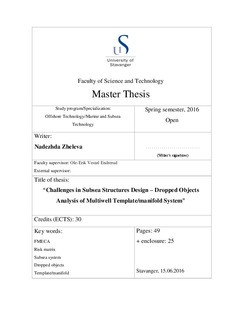| dc.description.abstract | Nowadays, the production of oil and gas has a major importance to the stability of the world’s energy supply. Almost 80 percent of the world’s energy consumption comes from fossil fuels (oil, gas, and coals), and around 30 percent of these fuels comes from offshore fields and will continue to increase in the future. Developing and exploration of the offshore fields lead to increasing the subsea facilities installed and the number of marine operations. Every offshore activity entails a risk of accidents with severe consequences. A great number of accidents are caused by falling free objects. This results in a damage of the subsea facilities and leads to a loss of containment, production time and financial assets. In some areas of the world, the regulations and legislations require a protection of the subsea system against dropped objects impact. In these regions multiwell template/manifold system is widely used as a part of subsea production system.
The main focus in this thesis is an estimation of the most critical components of the multiwell manifold/template system, with respect to the production if the system is exposed to dropped objects impact. For the purpose of the analysis, Failure Mode, Effects and Criticality Analysis (FMECA) is carried out. All the system elements are estimated and analyzed and according to their failure rate and severity of occurrence, they are plotted in a risk matrix. The most critical components, which have significant importance for the system reliability and performance, are obtained according to the risk level identification in the risk matrix.
The results derived from the analysis indicate that the template protective structure is the most critical unit in the system. A failure of the template may lead to damage of the equipment, which is important for the reliability of the system and the production of hydrocarbons. Thus the protection structure design is necessary for the subsea structures to ensure the safety of the system during installation and exploitation, and to minimize the risk. | nb_NO |
